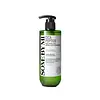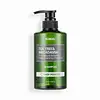What's inside
What's inside
 Key Ingredients
Key Ingredients

 Benefits
Benefits

 Concerns
Concerns

 Ingredients Side-by-side
Ingredients Side-by-side

Water
Skin ConditioningCocamidopropyl Betaine
CleansingTea-Cocoyl Glutamate
CleansingSodium Lauroyl Methylaminopropionate
CleansingDisodium Laureth Sulfosuccinate
CleansingCocamide Mea
EmulsifyingSodium Chloride
MaskingParfum
MaskingPolyquaternium-10
Caprylyl Glycol
EmollientHydroxyacetophenone
AntioxidantPPG-3 Myristyl Ether
EmollientPanthenol
Skin ConditioningSalicylic Acid
MaskingMenthol
MaskingCitric Acid
BufferingNiacinamide
SmoothingSodium Benzoate
MaskingPentasodium Pentetate
Butylene Glycol
HumectantGluconolactone
Skin ConditioningAminomethyl Propanol
Buffering1,2-Hexanediol
Skin ConditioningBiotin
AntiseborrhoeicMentha Piperita Leaf Extract
Skin ConditioningMentha Viridis Extract
MaskingLeonurus Sibiricus Flower/Leaf/Stem Extract
SoothingNelumbo Nucifera Flower Extract
Skin ConditioningHouttuynia Cordata Extract
Skin ConditioningArtemisia Vulgaris Extract
Skin ConditioningCamellia Sinensis Leaf Extract
AntimicrobialMentha Rotundifolia Leaf Extract
TonicCentella Asiatica Extract
CleansingEthylhexylglycerin
Skin ConditioningHydrolyzed Corn Protein
Skin ConditioningHydrolyzed Soy Protein
HumectantHydrolyzed Wheat Protein
Skin ConditioningHexapeptide-9
Skin ConditioningPalmitoyl Pentapeptide-4
Skin ConditioningPalmitoyl Tripeptide-5
Skin ConditioningPalmitoyl Tripeptide-1
Skin ConditioningPalmitoyl Tetrapeptide-7
Skin ConditioningPalmitoyl Oligopeptide
CleansingTripeptide-1
Skin ConditioningCopper Tripeptide-1
Skin ConditioningAsiatic Acid
Skin ConditioningAsiaticoside
AntioxidantAcetyl Hexapeptide-8
HumectantAcetyl Tetrapeptide-2
Skin ConditioningMadecassic Acid
Skin ConditioningMadecassoside
AntioxidantNonapeptide-1
Skin ConditioningWater, Cocamidopropyl Betaine, Tea-Cocoyl Glutamate, Sodium Lauroyl Methylaminopropionate, Disodium Laureth Sulfosuccinate, Cocamide Mea, Sodium Chloride, Parfum, Polyquaternium-10, Caprylyl Glycol, Hydroxyacetophenone, PPG-3 Myristyl Ether, Panthenol, Salicylic Acid, Menthol, Citric Acid, Niacinamide, Sodium Benzoate, Pentasodium Pentetate, Butylene Glycol, Gluconolactone, Aminomethyl Propanol, 1,2-Hexanediol, Biotin, Mentha Piperita Leaf Extract, Mentha Viridis Extract, Leonurus Sibiricus Flower/Leaf/Stem Extract, Nelumbo Nucifera Flower Extract, Houttuynia Cordata Extract, Artemisia Vulgaris Extract, Camellia Sinensis Leaf Extract, Mentha Rotundifolia Leaf Extract, Centella Asiatica Extract, Ethylhexylglycerin, Hydrolyzed Corn Protein, Hydrolyzed Soy Protein, Hydrolyzed Wheat Protein, Hexapeptide-9, Palmitoyl Pentapeptide-4, Palmitoyl Tripeptide-5, Palmitoyl Tripeptide-1, Palmitoyl Tetrapeptide-7, Palmitoyl Oligopeptide, Tripeptide-1, Copper Tripeptide-1, Asiatic Acid, Asiaticoside, Acetyl Hexapeptide-8, Acetyl Tetrapeptide-2, Madecassic Acid, Madecassoside, Nonapeptide-1
Water
Skin ConditioningSodium Cocoyl Alaninate
Lauryl Hydroxysultaine
CleansingLauryl Glucoside
CleansingSodium Cocoyl Isethionate
CleansingErythritol
HumectantGlycerin
HumectantPeat Water
Skin ConditioningMelaleuca Alternifolia Leaf Extract
PerfumingMacadamia Ternifolia Seed Extract
EmollientHoney Extract
HumectantSesamum Indicum Seed Extract
Skin ConditioningGlycine Soja Seed Extract
Skin ConditioningSophora Flavescens Root Extract
AntioxidantAvena Sativa Kernel Extract
AbrasivePanicum Miliaceum Seed Extract
Skin ConditioningVigna Radiata Seed Extract
Skin ConditioningCamellia Sinensis Seed Extract
HumectantCodonopsis Lanceolata Root Extract
Skin ConditioningPerilla Ocymoides Seed Extract
AntioxidantPeucedanum Graveolens Extract
TonicLavandula Angustifolia Flower Extract
CleansingMelissa Officinalis Leaf Extract
Skin ConditioningRosmarinus Officinalis Leaf Extract
AntimicrobialAspalathus Linearis Leaf Extract
Skin ConditioningSalvia Hispanica Seed Extract
EmollientCentella Asiatica Extract
CleansingHordeum Vulgare Seed Extract
Skin ConditioningSaponaria Officinalis Extract
Skin ConditioningSalvia Officinalis Leaf Extract
CleansingOlea Europaea Leaf Extract
PerfumingArctium Lappa Root Extract
Skin ConditioningLaurus Nobilis Leaf Extract
MaskingEucalyptus Globulus Leaf Extract
PerfumingCoix Lacryma-Jobi Ma-Yuen Seed Extract
Skin ConditioningLeonurus Sibiricus Extract
Skin ConditioningPanax Ginseng Root Extract
EmollientCarthamus Tinctorius Flower Extract
Skin ConditioningRosa Hybrid Flower Extract
Skin ConditioningAnemarrhena Asphodeloides Root Extract
Skin ConditioningLithospermum Erythrorhizon Root Extract
Skin ConditioningRehmannia Chinensis Root Extract
Skin ConditioningAngelica Gigas Root Extract
Skin ConditioningAcorus Calamus Root Extract
PerfumingCnidium Officinale Root Extract
Skin ConditioningPueraria Lobata Root Extract
HumectantChenopodium Quinoa Seed Extract
Skin ConditioningPolygonum Multiflorum Root Extract
Skin ConditioningSecale Cereale Seed Extract
AbrasiveScutellaria Baicalensis Root Extract
AstringentFoeniculum Vulgare Seed Extract
Skin ConditioningHibiscus Sabdariffa Flower Extract
Skin ConditioningArgania Spinosa Kernel Oil
EmollientMacadamia Integrifolia Seed Oil
Skin ConditioningButyrospermum Parkii Butter
Skin ConditioningPersea Gratissima Oil
Skin ConditioningCocos Nucifera Oil
MaskingSimmondsia Chinensis Seed Oil
EmollientHydroxyacetophenone
AntioxidantSodium Isethionate
CleansingPolyquaternium-10
Menthol
MaskingSodium Gluconate
Skin ConditioningArginine
MaskingSodium Chloride
MaskingCoconut Acid
CleansingCitric Acid
BufferingDipropylene Glycol
HumectantCaprylyl Glycol
EmollientEthylhexylglycerin
Skin Conditioning1,2-Hexanediol
Skin ConditioningDipotassium Glycyrrhizate
HumectantParfum
MaskingWater, Sodium Cocoyl Alaninate, Lauryl Hydroxysultaine, Lauryl Glucoside, Sodium Cocoyl Isethionate, Erythritol, Glycerin, Peat Water, Melaleuca Alternifolia Leaf Extract, Macadamia Ternifolia Seed Extract, Honey Extract, Sesamum Indicum Seed Extract, Glycine Soja Seed Extract, Sophora Flavescens Root Extract, Avena Sativa Kernel Extract, Panicum Miliaceum Seed Extract, Vigna Radiata Seed Extract, Camellia Sinensis Seed Extract, Codonopsis Lanceolata Root Extract, Perilla Ocymoides Seed Extract, Peucedanum Graveolens Extract, Lavandula Angustifolia Flower Extract, Melissa Officinalis Leaf Extract, Rosmarinus Officinalis Leaf Extract, Aspalathus Linearis Leaf Extract, Salvia Hispanica Seed Extract, Centella Asiatica Extract, Hordeum Vulgare Seed Extract, Saponaria Officinalis Extract, Salvia Officinalis Leaf Extract, Olea Europaea Leaf Extract, Arctium Lappa Root Extract, Laurus Nobilis Leaf Extract, Eucalyptus Globulus Leaf Extract, Coix Lacryma-Jobi Ma-Yuen Seed Extract, Leonurus Sibiricus Extract, Panax Ginseng Root Extract, Carthamus Tinctorius Flower Extract, Rosa Hybrid Flower Extract, Anemarrhena Asphodeloides Root Extract, Lithospermum Erythrorhizon Root Extract, Rehmannia Chinensis Root Extract, Angelica Gigas Root Extract, Acorus Calamus Root Extract, Cnidium Officinale Root Extract, Pueraria Lobata Root Extract, Chenopodium Quinoa Seed Extract, Polygonum Multiflorum Root Extract, Secale Cereale Seed Extract, Scutellaria Baicalensis Root Extract, Foeniculum Vulgare Seed Extract, Hibiscus Sabdariffa Flower Extract, Argania Spinosa Kernel Oil, Macadamia Integrifolia Seed Oil, Butyrospermum Parkii Butter, Persea Gratissima Oil, Cocos Nucifera Oil, Simmondsia Chinensis Seed Oil, Hydroxyacetophenone, Sodium Isethionate, Polyquaternium-10, Menthol, Sodium Gluconate, Arginine, Sodium Chloride, Coconut Acid, Citric Acid, Dipropylene Glycol, Caprylyl Glycol, Ethylhexylglycerin, 1,2-Hexanediol, Dipotassium Glycyrrhizate, Parfum
 Reviews
Reviews

Ingredients Explained
These ingredients are found in both products.
Ingredients higher up in an ingredient list are typically present in a larger amount.
1,2-Hexanediol is a synthetic liquid and another multi-functional powerhouse.
It is a:
- Humectant, drawing moisture into the skin
- Emollient, helping to soften skin
- Solvent, dispersing and stabilizing formulas
- Preservative booster, enhancing the antimicrobial activity of other preservatives
Caprylyl Glycol is a humectant and emollient, meaning it attracts and preserves moisture.
It is a common ingredient in many products, especially those designed to hydrate skin. The primary benefits are retaining moisture, skin softening, and promoting a healthy skin barrier.
Though Caprylyl Glycol is an alcohol derived from fatty acids, it is not the kind that can dry out skin.
This ingredient is also used as a preservative to extend the life of products. It has slight antimicrobial properties.
Learn more about Caprylyl GlycolCentella Asiatica Extract (Centella) is derived from an herb native to Southeast Asia. It is famous for its anti-inflammatory and soothing properties.
Centella is rich in antioxidants and amino acids, such as Madecassic Acid and Asiaticoside.
Studies show the compounds in centella help with:
The combination of all these properties makes centella effective at soothing, hydrating, and protecting the skin.
Other great components of centella include Vitamin A, vitamin C, several B vitamins, and Asiatic Acid.
Fun fact: Centella has been used as a medicine and in food for many centuries. As a medicine, it is used to treat burns, scratches, and wounds.
Learn more about Centella Asiatica ExtractCitric Acid is an alpha hydroxy acid (AHA) naturally found in citrus fruits like oranges, lemons, and limes.
Like other AHAs, citric acid can exfoliate skin by breaking down the bonds that hold dead skin cells together. This helps reveal smoother and brighter skin underneath.
However, this exfoliating effect only happens at high concentrations (20%) which can be hard to find in cosmetic products.
Due to this, citric acid is usually included in small amounts as a pH adjuster. This helps keep products slightly more acidic and compatible with skin's natural pH.
In skincare formulas, citric acid can:
While it can provide some skin benefits, research shows lactic acid and glycolic acid are generally more effective and less irritating exfoliants.
Most citric acid used in skincare today is made by fermenting sugars (usually from molasses). This synthetic version is identical to the natural citrus form but easier to stabilize and use in formulations.
Read more about some other popular AHA's here:
Learn more about Citric AcidEthylhexylglycerin (we can't pronounce this either) is commonly used as a preservative and skin softener. It is derived from glyceryl.
You might see Ethylhexylglycerin often paired with other preservatives such as phenoxyethanol. Ethylhexylglycerin has been found to increase the effectiveness of these other preservatives.
Hydroxyacetophenone is antioxidant with skin conditioning and soothing properties. It also boosts the efficiency of preservatives.
This ingredient is not irritating or sensitizing.
Menthol is a compound found in mint plants, such as peppermint. In its pure form, it is a clear crystalline substance.
Menthol is known for its cooling sensation; however, the cooling is actually from your skin being sensitized. Menthol can worsen rosacea. We recommend speaking with a professional if you have concerns.
Menthol also has antimicrobial properties.
Learn more about MentholParfum is a catch-all term for an ingredient or more that is used to give a scent to products.
Also called "fragrance", this ingredient can be a blend of hundreds of chemicals or plant oils. This means every product with "fragrance" or "parfum" in the ingredients list is a different mixture.
For instance, Habanolide is a proprietary trade name for a specific aroma chemical. When used as a fragrance ingredient in cosmetics, most aroma chemicals fall under the broad labeling category of “FRAGRANCE” or “PARFUM” according to EU and US regulations.
The term 'parfum' or 'fragrance' is not regulated in many countries. In many cases, it is up to the brand to define this term.
For instance, many brands choose to label themselves as "fragrance-free" because they are not using synthetic fragrances. However, their products may still contain ingredients such as essential oils that are considered a fragrance by INCI standards.
One example is Calendula flower extract. Calendula is an essential oil that still imparts a scent or 'fragrance'.
Depending on the blend, the ingredients in the mixture can cause allergies and sensitivities on the skin. Some ingredients that are known EU allergens include linalool and citronellol.
Parfum can also be used to mask or cover an unpleasant scent.
The bottom line is: not all fragrances/parfum/ingredients are created equally. If you are worried about fragrances, we recommend taking a closer look at an ingredient. And of course, we always recommend speaking with a professional.
Learn more about ParfumPolyquaternium-10 is an ammonium salt of hydroxyethylcellulose. It is a white and granular powder used as a film-former and anti-static agent.
This ingredient is commonly found in hair conditioning products. According to a manufacturer, its positive charge makes it great for absorbing hair proteins. The manufacturer also states this ingredient helps with curl retention.
For haircare friends: this ingredient is not a silicone.
Learn more about Polyquaternium-10Chances are, you eat sodium chloride every day. Sodium Chloride is also known as table salt.
This ingredient has many purposes in skincare: thickener, emulsifier, and exfoliator.
You'll most likely find this ingredient in cleansers where it is used to create a gel-like texture. As an emulsifier, it also prevents ingredients from separating.
There is much debate on whether this ingredient is comedogenic. The short answer - comedogenic ratings don't tell the whole story. Learn more about comegodenic ratings here.
The concensus about this ingredient causing acne seems to be divided. Research is needed to understand if this ingredient does cause acne.
Scrubs may use salt as the primary exfoliating ingredient.
Learn more about Sodium ChlorideWater. It's the most common cosmetic ingredient of all. You'll usually see it at the top of ingredient lists, meaning that it makes up the largest part of the product.
So why is it so popular? Water most often acts as a solvent - this means that it helps dissolve other ingredients into the formulation.
You'll also recognize water as that liquid we all need to stay alive. If you see this, drink a glass of water. Stay hydrated!
Learn more about Water